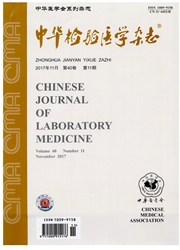

 中文摘要:
中文摘要:
目的评价血小板相关抗体IgG(PAIgG)初筛能否提高单克隆抗体特异性俘获血小板抗原(MAIPA)技术对免疫性血小板减少性紫癜(ITP)诊断的敏感性。方法用酶联免疫吸附竞争法检测PAIgG,改良MAIPA技术检测抗血小板GPⅡb/Ⅲa、GPⅠb/Ⅸ特异性抗体;190例血小板减少症患者同时行PAIgG及MAIPA检测,其中132例为ITP患者;采用Kappa检验进行两种诊断试验的一致性分析。结果单做PAIgG及PAIgG与MAIPA并联诊断ITP的敏感度分别为85.6%和90.2%,较单做MAIPA(53.0%)分别提高32.6%与37.2%;特异度分别为29.3%和24.1%,较单做MAIPA(81.0%)则分别下降51.7%与56.9%;PAIgG与MAIPA串联诊断ITP的敏感度、特异度、阳性预测值、阴性预测值分别为48.5%、86.2%、88.9%和42.4%,均与单做MAIPA相当。ITP与非免疫性血小板减少症患者PAIgG与MAIPA测定结果之间的Kappa值分别为0.129与0.012,即两种试验对ITP及非免疫性血小板减少症诊断的一致性均较差。结论PAIgG检测不能作为MAIPA的过筛试验。
 英文摘要:
英文摘要:
Objective To evaluate if the assay of platelet-associated immunoglobulin G (PAIgG) can improve the sensitivity of monoclonal antibody immobilization of platelet antigens assay (MAIPA) in immune thrombocytopenic purpura (ITP). Methods Anti-GP Ⅱ b/Ⅲ a and anti-GP Ⅰb/IX autoantibodies were detected by a modified MAIPA; PAIgG was detected by competitive ELISA. MAIPA and PAIgG were done simultaneously in 190 patients with thrombocytopenia, in which 132 were diagnosed as ITP according to the diagnostic criteria. Kappa test was used to analyze the concordance between MAIPA and PAIgG. Results The sensitivities of PAIgG alone or in parallel with MAIPA to ITP were 32. 6% and 37. 2% higher than MAIPA alone respectively, while their specificities were 51.7% and 56. 9% lower respectively. The sensitivity, specificity, positive predictive value, negative predictive value of PAIgG in series with MAIPA were all not superior to MAIPA alone. The kappa values between MAIPA and PAIgG in ITP and non-immune thrombocytopenia were 0. 129 and 0. 012 respectively, which meant the concordance between them was poor. Conclusion The detection of PAIgG should not be used as screening before MAIPA in distinguishing immune from non-immune thrombocytopenia.
 同期刊论文项目
同期刊论文项目
 同项目期刊论文
同项目期刊论文
 De novo induction of platelet-specific CD4+CD25+ regulatory T cells from CD4+CD25- cells in patients
De novo induction of platelet-specific CD4+CD25+ regulatory T cells from CD4+CD25- cells in patients Effects of IgG and its F(ab)2 fragments of some patients with idiopathic thrombocytopenic purpura on
Effects of IgG and its F(ab)2 fragments of some patients with idiopathic thrombocytopenic purpura on Identification of anergy-related ge nes in idiopathic thrombocytopenic purpura using microarray anal
Identification of anergy-related ge nes in idiopathic thrombocytopenic purpura using microarray anal Polarization of natural killer T cells towards an NKT2 subpopulation occurs after stimulation with a
Polarization of natural killer T cells towards an NKT2 subpopulation occurs after stimulation with a Increased cytotoxic T-lymphocyte-mediated cytotoxicity predominant in patients with idiopathic throm
Increased cytotoxic T-lymphocyte-mediated cytotoxicity predominant in patients with idiopathic throm Cell-Based Immunotherapy with Different Subsets of Tolerogenic Dendritic Cell in Idiopathic Thromboc
Cell-Based Immunotherapy with Different Subsets of Tolerogenic Dendritic Cell in Idiopathic Thromboc Modulation of immune response with cytotoxic T-lymphocyteassociated antigen 4 immunoglobulin-induced
Modulation of immune response with cytotoxic T-lymphocyteassociated antigen 4 immunoglobulin-induced 期刊信息
期刊信息
